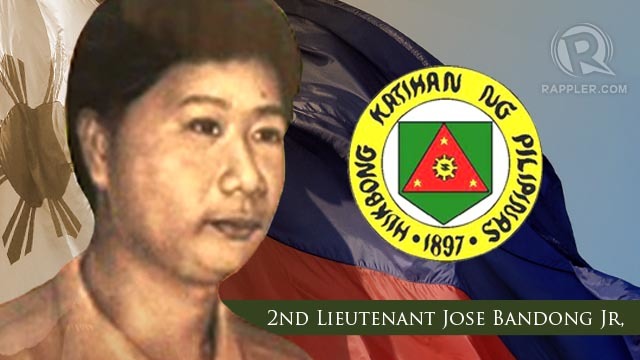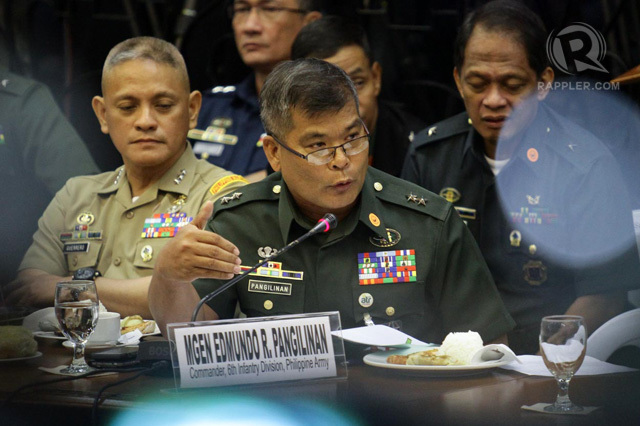It happened in the Mountain Province, where an Army lieutenant ordered to be fired at to save his retreating men

HIGHEST COMBAT HONOR: Medal for Valor awardee 2Lt Jose Bandong
It was a question that lawmakers would ask the military many times during the hearing on Mamasapano: why did you come in late to help the beleaguered Special Action Force troops on January 25?
On Day 2 of the Senate hearing, an emotional Interior Secretary Manuel Roxas II expressed his frustration over the decision of the Army's 6th Infantry Division (ID) to withhold artillery support for SAF commandos trapped in Barangay Tukanalipao, Mamasapano, on the morning of January 25.
"Ang nasa isip ko naman po ay mayroong konsepto rin ng fire on my location. Sinasalakay na kami. Uubusin na kami rito. We will take our chances na you fire on our position because at least may chance na hindi kami tamaan. Pero may chance na tatamaan ang kalaban.Kaysa hindi kayo mag-fire, ubos kami dito," Roxas said on Day 2 of Senate hearing on February 10. (What’s on my mind is the concept of "fire on my location."
We’re being attacked, we’re being annihilated. We will take our chances that you fire on our positions because at least there’s a chance that we won’t be hit but the enemy will.)
Fire on location? It sounds like a war movie, but a number of military officers swear it happened in the Mountain Province in the '90s.
"It happened in the North. Overwhelming ang kalaban so he ordered 'fire on my position.' It's a very extreme measure. It's suicidal," Brigadier General Carlito Galvez told Rappler.

FOLLOWING THE DOCTRINE: Army 6th Infantry Division commander Major General Pangilinan stands by his decision to withhold artillery fire during the Mamasapano clash
Bandong's platoon was overwhelmed by the communist New People's Army (NPA) – particularly the unit called Chadli Molintas Command-Regional Unit Guerrilla. He ordered his men to withdraw while he stayed in the battlefield and engaged the enemy up to his last bullet. He continuously fired at them to allow his men to get away.
Based on the accounts of the officers, Bandong later called his troops manning the artillery and gave his final orders: "Fire on my location."
He died along with the communist rebels. But his men managed to withdraw and survive.
Bandong posthumously received the Medal of Valor for heroism in the battlefield. His photo is displayed in the lobby of the Armed Forces headquarters in Camp Aguinaldo, along with other recipients of the military's highest combat honor.
Long and last battle
Only a 2nd Lieutenant during the encounter, Bandong had only been in the service for a few years.
The last battle of his life was a long one. It started with a 6-hour firefight, where Bandong and about 35 soldiers overwhelmed an estimated 20 communist guerrillas and forced them to withdraw. It didn't end there, however.
As the platoon prepared for evacuation, one team that was supposed to secure the route was ambushed by about 30 rebels. A firefight dragged for 3 hours, and the soldiers called for reinforcement.
Bandong led the other team to link up with his beleaguered men when another group of communist rebels showed up and attacked them from the rear. The soldiers fought back in yet another intense firefight that hit Bandong on the left shoulder. Seeing that they were outnumbered, Bandong ordered his men to withdraw.
On the wall in Camp Aguinaldo, the citation for Bandong reads: "By this display of heroism Second Lieutenant Jose Bandong Jr upheld the highest virtue of military leadership and professionalism, thus earning distinct credit for himself and the Armed Forces of the Philippines." (Read the complete citation here.)
His citation doesn't talk about the suicidal order, but 3 other military officers aside from Galvez confirmed to Rappler the story that has been repeatedly told by soldiers.
Incomplete information
Back in the Senate hearing, the commander of the 6th ID, Major General Edmundo Pangilinan, maintained that he doesn't regret withholding artillery fire in the morning of January 25.
"Baka mas malaki ang problema kung nagpaputok kami," he said. (Firing artillery at the time would have caused bigger problems for us.)
The military did not have enough information, such as location of the target, when the request was made, Pangilinan explained. "Hindi kami nagpapatutok, we didn’t have a clear picture [to be able to] provide artillery fire support. It's doctrinal, not judgment," Pangilinan said.
But some senators expressed disbelief. Senator Alan Cayetano even boasted he could easily get the coordinates of someone's location from telecommunication companies.
It would take Senator Antonio Trillanes IV, a soldier-turned-rebel-turned-senator, to defend the military.
"Ang sinasabi ni General Pangilinan, nag-stick siya sa protocol. Ang advice ko, General Pangilinan is you continue to stick to that. Let not this hearing na parang bine-blame ang Army change that doctrine," Trillanes said in a manifestation. (What General Pangilinan is saying is that he stood by the protocol. My advice to you, General Pangilinan, is to continue to stick to that.)
"Kung sakali lang na nagpaputok kayo ng artillery without the necessary information at yoon ang pumatay sa mga SAF troopers natin, palagay ko 'yun ang hearing natin ngayon. Bakit pinaputok na kulang ang information. Mas mahirap 'yun. Or worse, kung may napatakan na civilian," Trillanes added. (Had you fired artillery without necessary information and it killed the SAF troopers, then that would be the subject of our hearing now. You would be asked, why did you fire based on incomplete information? That's more difficult. Worse, what if that killed civilians?)
In the case of Bandong, he provided his grid coordinates and also served as the forward observer.
Still, the debate was not over on Day 2.
It was raised again in the House of Representatives even as the military had by then updated its presentation to explain the kind of information they lacked that morning to be able to help the 55th SAF company in Barangay Tukanalipao, which lost 35 of its 36 troopers that day.
The military said they were only able to get the information late in the afternoon, prompting them to finally rescue the other SAF group, the 84th SAF company, that trapped in another barangay.
They needed the location of the friendly forces, the enemy, and the critical forward observer to confirm that the targets were correct. "Communication is extremely essential between the forward observer and the fire base before a fire mission is granted in order to prevent fratricide or what we call friendly fire or any possible collateral damage," Pangilinan said.
The explanation did not satisfy lawmakers. On Day 3 of the Senate probe on Thursday, February 12, the issue was raised again:
Senator Ferdinand Marcos: If there had been a direct order from the President to conduct a fire mission in support of the PNP SAF who were pinned down, would you have ordered that fire mission?
General Pangilinan: Your honor, just the same I will follow the doctrine.
Senator Marcos: You will defy the President?
General Pangilinan: Because there is a doctrine that we need to follow. Unless the one that is requesting asked that it be fired from his position. The one that is requesting is the one that is engaged...probably, your honor.
The officers remembered Bandong's story all over again.

No comments:
Post a Comment
Note: Only a member of this blog may post a comment.